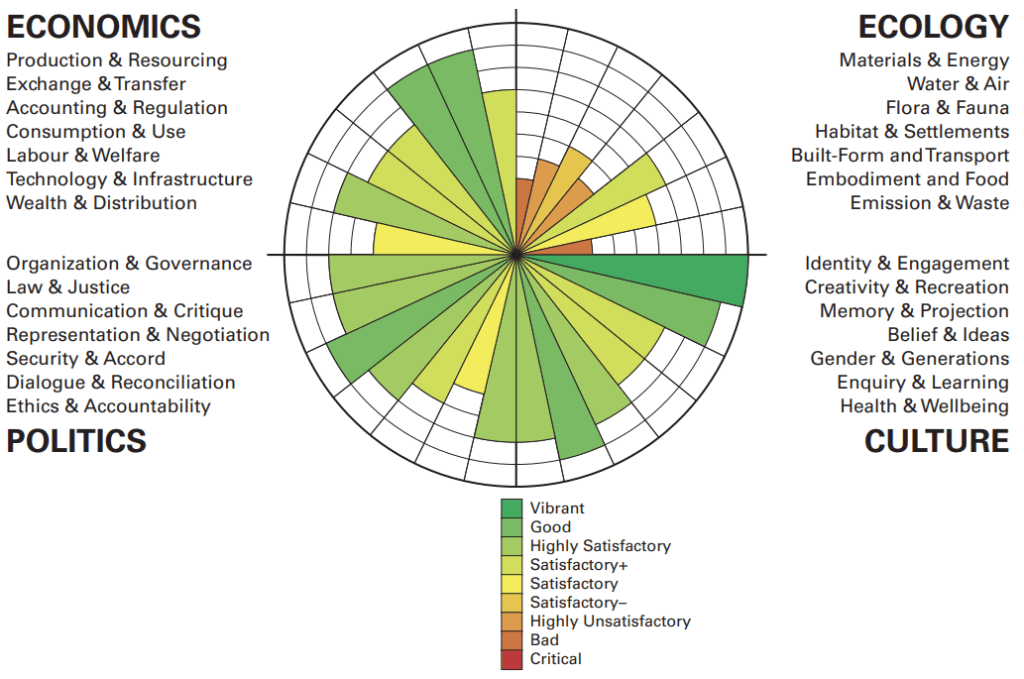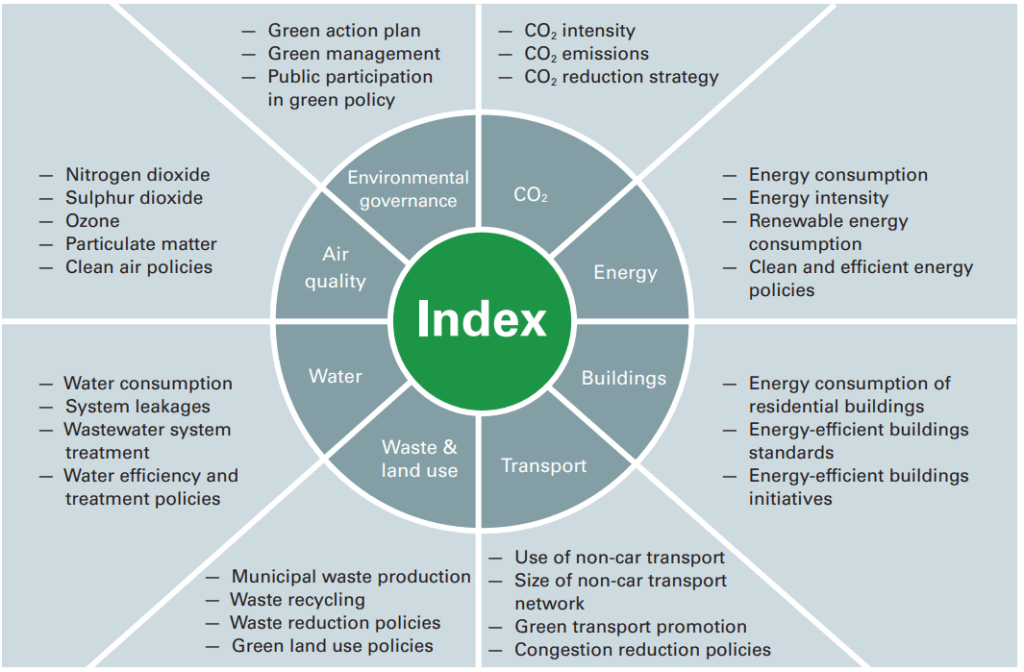As the world becomes more urbanised, design and management of cities will play an increasingly important role in mitigating how climate change affects communities. Sustainable urban development practices can help reduce greenhouse gas emissions, while also making cities more resilient to the impacts of climate change.
How crucial Are sustainable cities?
A sustainable city and/or community manages resources for present and future generations. Good planning, development and management of urban areas drives the sustainable use of resources and the social, environmental and economic impacts of climate change. This kind of management is essential to addressing how climate change affects communities.

Source: Rogers, 1997.
According to the United Nations, there are two main focuses of sustainable cities:
- Guidelines for sustainable consumption and production that encompass all city sectors.
- Reducing and managing pollution and waste through increased interventions via policy, technology and financing.
Although cities cover only 3% of Earth’s land mass, they account for 60-80% of energy consumption, and approximately 75% of carbon emissions. Consequently, the UN created the Sustainable Development Goal (SDG) 11: Sustainable Cities and Communities. The goal aims to develop cities and communities in order to provide basic services, energy, housing, transportation and green spaces for everyone while simultaneously reducing resource and environmental impacts.
Furthermore, the future development of cities will provide the example for the rest of the world to follow. They will show how greater sustainability is possible whilst using less of the Earth’s resources.
what does a sustainable city and community look like and how does it function?
In recent years, there has been a growing movement towards sustainable city planning. More and more cities are implementing green infrastructure and investing in renewable energy. Sustainable cities are not only better for the environment but have a number of other benefits. Firstly, they tend to be more liveable and efficient, with better air quality and less noise. They also enjoy greater equity, lower crime rates, and better housing. In a sustainable city, residents can enjoy a higher quality of life while also doing their part to protect the planet. With the challenges of global warming looming ever larger, sustainable cities will be crucial to our ability to deal with how climate change affects communities.
Sustainable cities are comprise many factors including, but not limited to:
- Sustainable housing
- Efficient use of energy
- Efficient use of water supplies
- Effective wastewater treatment and recycling
- Cleaning of rivers within cities
- Waste and recycling collection and removal
- Open spaces and green areas
Furthermore, a number of modern cities meet this definition of sustainability. They include: Canberra, Australia, Copenhagen, Denmark; and San Francisco, California. All of these cities have focused on various factors to attain the ranking of a sustainable city. Copenhagen aims to reach carbon neutrality by 2025, and San Francisco redirects 80% of its waste.
What methods are used to measure sustainability in cities?
There are four accepted methods to measure sustainability in cities. Stakeholders use these various approaches to analyse the development of cities and make informed decisions.
- The Circles of Sustainability model developed by the Global Compact Cities Initiative
The Circles of Sustainability model asks four questions relating to four more detailed ‘circles’. Firstly, profile circles determine a community’s strength and weakness. Secondly, process circles provide a more sustainable pathway for professionals. Thirdly, engagement circles involve other groups and individuals in the process of reaching sustainability. Lastly, knowledge circles question impacts and push for a variety of interpretations as opposed to a single fix. Hence, the idea behind circular guidelines.

Source: KPMG
2. The Green City Index
The Green City Index uses 30 indicators, of which half are quantitative and half are qualitative. The indicators vary across 9 categories ranging from air quality, CO2 emissions, energy use, infrastructure, land use, transport, water and sanitation, waste management, and environmental governance.

Source: KPMG
3. The Improvement in Efficiency Social Enterprise (IESE) Cities in Motion Index
The IESE Cities in Motion Index aims to advance knowledge and sustainable innovations within cities. It analyses 9 essential ‘dimensions’ of cities: human capital, social cohesion, the economy, governance, the environment, mobility and transportation, urban planning, international projection, and technology.

Source: KPMG
4. The GNH Index developed by the Happiness Alliance
The Gross National Happiness Index uses 9 key elements to determine a city’s sustainability: psychological well-being, physical health, time or work–life balance, social vitality and connection, education, arts and culture, environment and nature, good government and material well-being. The idea steams from Bhutan and the key elements are drawn from Bhutanese values.

Source: KPMG
How Climate Change Affects Communities
Climate change is a global phenomenon that largely impacts urban life. Rising global temperatures cause sea levels to rise, increase the number of extreme weather events such as floods, droughts and storms, and increase the spread of tropical disease. All of these effects create costly impacts on cities’ basic services, infrastructure, housing, human livelihoods and health.
Further, urban activities are a major contributor to greenhouse gas emissions. They emit approximately 75% of global carbon dioxide. Transport and buildings are the largest source of CO2. Consequently, the development of sustainable cities is critical to mitigating climate change.
Therefore, the Sustainable Development Goal 13 (SDG 13: Climate Change) is crucial as it impacts upon all Sustainable Development Goals. The development of sustainable communities and cities will aid in reducing climate change.
Urbanisation And Climate Change
The importance of sustainable cities and communities is increasing as urban populations grow in size. It is estimated that two thirds of the worlds population will live in cities by 2030. Furthermore, by 2050, nearly 70% of people will be living in cities.

Source: United Nations Department of Economics and Social Affairs
Therefore, with greater populations, existing problems in cities will be exacerbated. The United Nations progress and information from 2022 reports that:
- 99% of urban populations breathe polluted air
- Municipal solid waste problems are increasing
- Only 37% of urban areas are covered by public transportation globally
Further, previous research from the United Nations concludes that climate change has the ability to worsen inequalities, especially impacting vulnerable communities. Thus, natural disasters such as droughts, flooding and fires will cause much greater damage to developing countries and poorer communities. The economic division between rich and poor countries is exacerbated by the climate crisis. Moreover, the inequalities and vulnerability in developing countries makes it even more difficult for them to make the transition towards sustainable cities.
So, what is the solution?
In order to achieve the goal of sustainable cities by 2030 there is a lot to do. The United Nations University suggests 5 ways to meet this goal:
- Create more sustainable public transportation.
- Increase nature-based work in cities.
- Develop disaster resilience via community networks.
- Advance smart solution technology.
- Create collaboration between cities, countries, and international bodies.
In addition, the World Economic and Social Survey 2016, revealed that transformative government policies can significantly enhance climate change resilience, thereby addressing a major cause of inequality.
There are also important interactions between the creation of sustainable communities and efforts to halt climate change that must be considered. That said, these kinds of interactions affect all of the sustainable development goals. Each has significant inter-relationships with the others.
The THRIVE Framework addresses this kind of complexity when it assesses the impact of actions on sustainability. It outlines the significance, scale, scope and shift of any activity’s effect on future sustainability performance.
Further, at THRIVE we look at the potential, not only for a sustainable future but for ‘thrivability‘. A thrivable future is one where the planet not only survives, but thrives, thanks to the application of currently available data and technological advances developed to serve humanity.
Visit the THRIVE website to find out more, and check out our informative blogs, podcasts, and monthly webinars on our discussion of thrivability.























